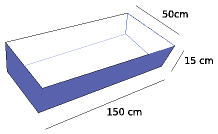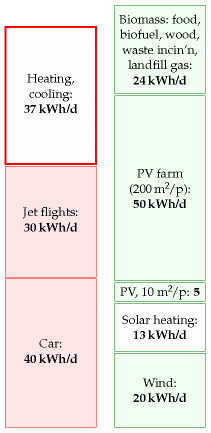

7 Heating and cooling
This chapter explores how much power we spend controlling the temperature of our surroundings – at home and at work – and on warming or cooling our food, drink, laundry, and dirty dishes.
Domestic water heating
The biggest use of hot water in a house might be baths, showers, dishwashing, or clothes-washing – it depends on your lifestyle. Let’s estimate first the energy used by taking a hot bath.
The volume of bath-water is 50 cm × 15 cm × 150 cm ≈ 110 litre. Say the temperature of the bath is 50 °C (120 °F) and the water coming into the house is at 10 °C. The heat capacity of water, which measures how much energy is required to heat it up, is 4200 J per litre per °C. So the energy required to heat up the water by 40 °C is
4200 J/litre/°C × 110 litre × 40 °C ≈ 18 MJ ≈ 5 kWh.
So taking a bath uses about 5 kWh. For comparison, taking a shower (30 litres) uses about 1.4 kWh.
Kettles and cookers
230 V × 13 A = 3000 W
Britain, being a civilized country, has a 230 volt domestic electricity supply. With this supply, we can use an electric kettle to boil several litres of water in a couple of minutes. Such kettles have a power of 3 kW. Why 3 kW? Because this is the biggest power that a 230 volt outlet can deliver without the current exceeding the maximum permitted, 13 amps. In countries where the voltage is 110 volts, it takes twice as long to make a pot of tea.

If a household has the kettle on for 20 minutes per day, that’s an average power consumption of 1 kWh per day. (I’ll work out the next few items “per household,” with 2 people per household.)
One small ring on an electric cooker has the same power as a toaster: 1 kW. The higher-power hot plates deliver 2.3 kW. If you use two rings of the cooker on full power for half an hour per day, that corresponds to 1.6 kWh per day.
A microwave oven usually has its cooking power marked on the front: mine says 900 W, but it actually consumes about 1.4 kW. If you use the microwave for 20 minutes per day, that’s 0.5 kWh per day.
A regular oven guzzles more: about 3 kW when on full. 1 If you use the oven for one hour per day, and the oven’s on full power for half of that time, that’s 1.5 kWh per day.
| Device | power | time per day | energy per day |
|---|---|---|---|
| Cooking | |||
| – kettle | 3 kW | 1⁄3 h | 1 kWh/d |
| – microwave | 1.4 kW | 1⁄3 h | 0.5 kWh/d |
| – electric cooker (rings) | 3.3 kW | 1⁄2 h | 1.6 kWh/d |
| – electric oven | 3 kW | 1⁄2 h | 1.5 kWh/d |
| Cleaning | |||
| – washing machine | 2.5 kW | 1 kWh/d | |
| – tumble dryer | 2.5 kW | 0.8 h | 2 kWh/d |
| – airing-cupboard drying | 0.5 kWh/d | ||
| – washing-line drying | 0 kWh/d | ||
| – dishwasher | 2.5 kW | 1.5 kWh/d | |
| Cooling | |||
| – refrigerator | 0.02 kW | 24 h | 0.5 kWh/d |
| – freezer | 0.09 kW | 24 h | 2.3 kWh/d |
| – air-conditioning | 0.6 kW | 1 h | 0.6 kWh/d |
Hot clothes and hot dishes
A clothes washer, dishwasher, and tumble dryer all use a power of about 2.5 kW when running.


A clothes washer uses about 80 litres of water per load, with an energy cost of about 1 kWh if the temperature is set to 40 °C. If we use an indoor airing-cupboard instead of a tumble dryer to dry clothes, heat is still required to evaporate the water – roughly 1.5 kWh to dry one load of clothes, instead of 3 kWh. 2
Totting up the estimates relating to hot water, I think it’s easy to use about 12 kWh per day per person.
Hot air – at home and at work
Now, does more power go into making hot water and hot food, or into making hot air via our buildings’ radiators?
One way to estimate the energy used per day for hot air is to imagine a building heated instead by electric fires, whose powers are more familiar to us. The power of a small electric bar fire or electric fan heater is 1 kW (24 kWh per day). In winter, you might need one of these per person to keep toasty. In summer, none. So we estimate that on average one modern person needs to use 12 kWh per day on hot air. But most people use more than they need, keeping several rooms warm simultaneously (kitchen, living room, corridor, and bathroom, say). So a plausible consumption figure for hot air is about double that: 24 kWh per day per person.
This chapter’s companion Chapter E contains a more detailed account of where the heat is going in a building; this model makes it possible to predict the heat savings from turning the thermostat down, double-glazing the windows, and so forth.

Warming the outdoors, and other luxuries
There’s a growing trend of warming the outdoors with patio heaters. Typical patio heaters have a power of 15 kW. So if you use one of these for a couple of hours every evening, you are using an extra 30 kWh per day.
A more modest luxury is an electric blanket. An electric blanket for a double bed uses 140 W; switching it on for one hour uses 0.14 kWh.
Cooling
Fridge and freezer
We control the temperatures not only of the hot water and hot air with which we surround ourselves, but also of the cold cupboards we squeeze into our hothouses. My fridge-freezer, pictured in figure 7.3, consumes 18 W on average – that’s roughly 0.5 kWh/d.
Air-conditioning
In countries where the temperature gets above 30 °C, air-conditioning is viewed as a necessity, and the energy cost of delivering that temperature control can be large. However, this part of the book is about British energy consumption, and Britain’s temperatures provide little need for air- conditioning (figure 7.8).

An economical way to get air-conditioning is an air-source heat pump. A window-mounted electric air-conditioning unit for a single room uses 0.6 kW of electricity and (by heat-exchanger) delivers 2.6 kW of cooling. To estimate how much energy someone might use in the UK, I assumed they might switch such an air-conditioning unit on for about 12 hours per day on 30 days of the year. On the days when it’s on, the air-conditioner uses 7.2 kWh. The average consumption over the whole year is 0.6 kWh/d.

This chapter’s estimate of the energy cost of cooling – 1 kWh/d per person – includes this air-conditioning and a domestic refrigerator.
Figure 7.10. My domestic cumulative gas consumption, in kWh, each year from 1993 to 2005. The number at the top of each year’s line is the average rate of energy consumption, in kWh per day. To find out what happened in 2007, keep reading\!Society also refrigerates food on its way from field to shopping basket. I’ll estimate the power cost of the food-chain later, in Chapter 15.
Total heating and cooling
Our rough estimate of the total energy that one person might spend on heating and cooling, including home, workplace, and cooking, is 37 kWh/d per person (12 for hot water, 24 for hot air, and 1 for cooling).
Evidence that this estimate is in the right ballpark, or perhaps a little on the low side, comes from my own domestic gas consumption, which for 12 years averaged 40 kWh per day (figure 7.10). At the time I thought I was a fairly frugal user of heating, but I wasn’t being attentive to my actual power consumption. Chapter 21 will reveal how much power I saved once I started paying attention.
Since heating is a big item in our consumption stack, let’s check my estimates against some national statistics. Nationally, the average domestic consumption for space heating, water, and cooking in the year 2000 was 21 kWh per day per person, and consumption in the service sector for heating, cooling, catering, and hot water was 8.5 kWh/d/p. 3 For an estimate of workplace heating, let’s take the gas consumption of the University of Cambridge in 2006–7: 16 kWh/d per employee. 4
Totting up these three numbers, a second guess for the national spend on heating is 21 + 8.5 + 16 ≈ 45 kWh/d per person, if Cambridge University is a normal workplace. Good, that’s reassuringly close to our first guess of 37 kWh/d.
Notes and further reading
- An oven uses 3 kW. Obviously there’s a range of powers. Many ovens have a maximum power of 1.8 kW or 2.2 kW. Top-of-the-line ovens use as much as 6 kW. For example, the Whirlpool AGB 487/WP 4 Hotplate Electric Oven Range has a 5.9 kW oven, and four 2.3 kW hotplates. www.kcmltd.com/electric oven ranges.shtml www.1stforkitchens.co.uk/kitchenovens.html↩
- An airing cupboard requires roughly 1.5 kWh to dry one load of clothes. I worked this out by weighing my laundry: a load of clothes, 4 kg when dry, emerged from my Bosch washing machine weighing 2.2 kg more (even after a good German spinning). The latent heat of vaporization of water at 15 °C is roughly 2500 kJ/kg. To obtain the daily figure in table 7.4 I assumed that one person has a load of laundry every three days, and that this sucks valuable heat from the house during the cold half of the year. (In summer, using the airing cupboard delivers a little bit of air-conditioning, since the evaporating water cools the air in the house.)↩
- Nationally, the average domestic consumption was 21 kWh/d/p; consumption in the service sector was 8.5 kWh/d/p. Source: Dept. of Trade and Industry (2002a).↩
- In 2006–7, Cambridge University’s gas consumption was 16 kWh/d per employee. The gas and oil consumption of the University of Cambridge (not including the Colleges) was 76 GWh in 2006–7. I declared the University to be the place of work of 13 300 people (8602 staff and 4667 postgraduate researchers). Its electricity consumption, incidentally, was 99.5 GWh. Source: University utilities report.↩